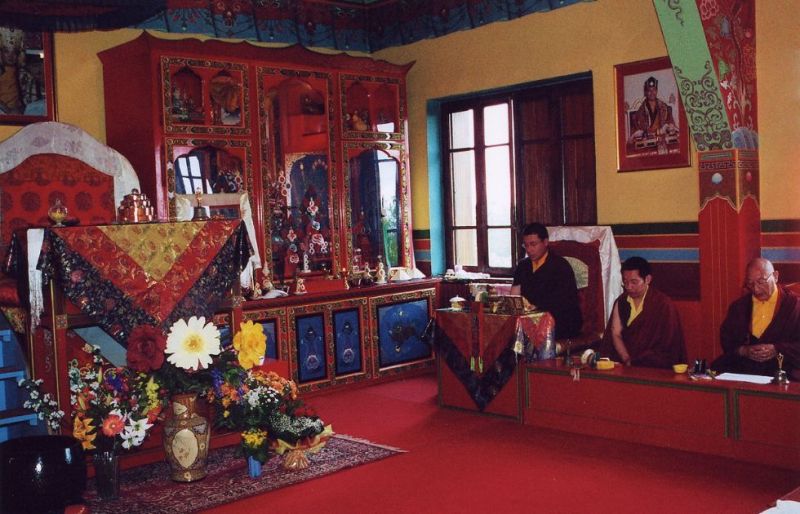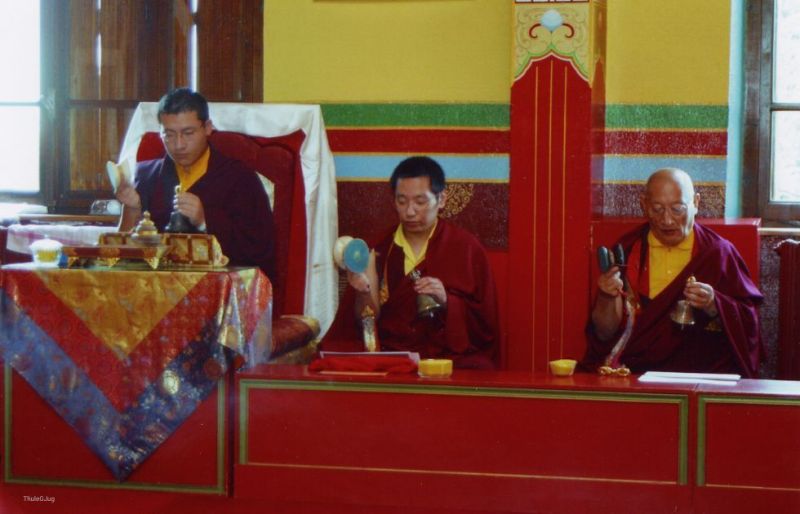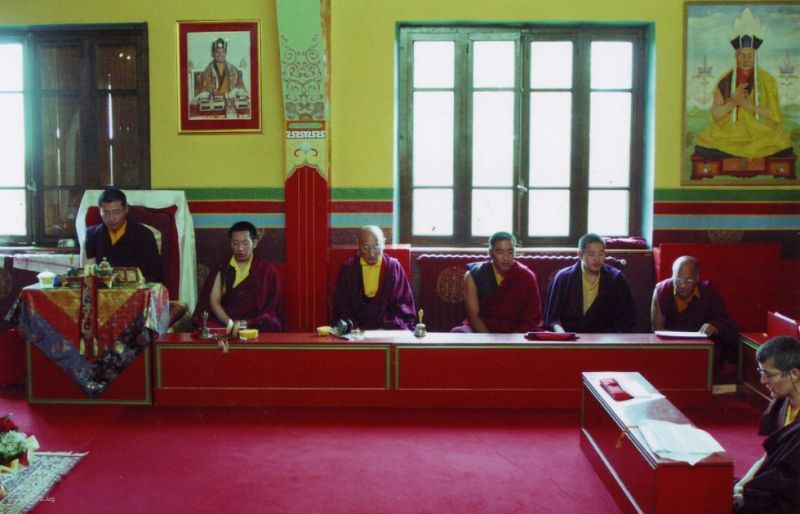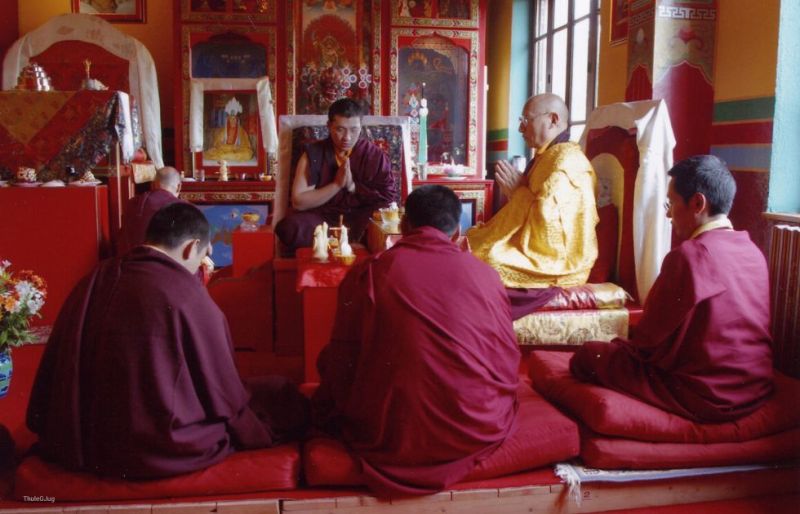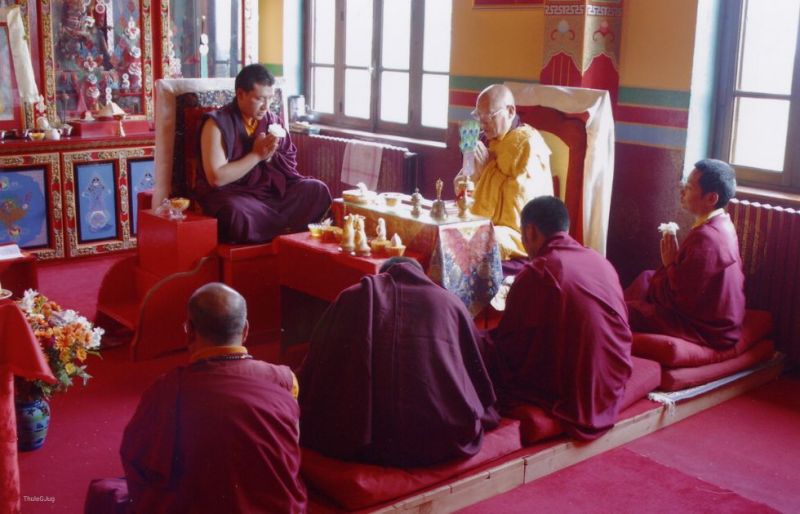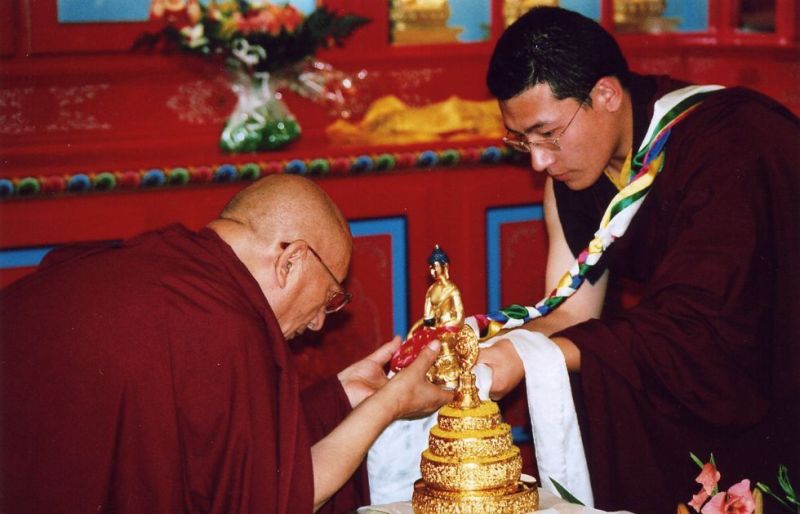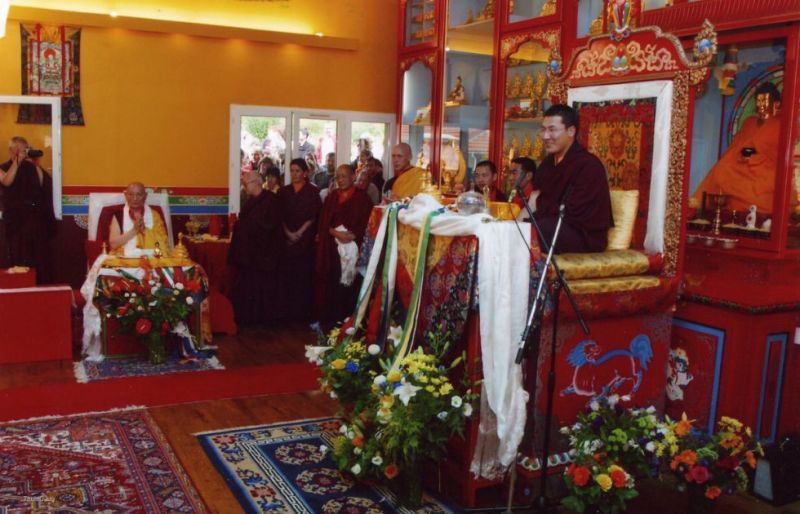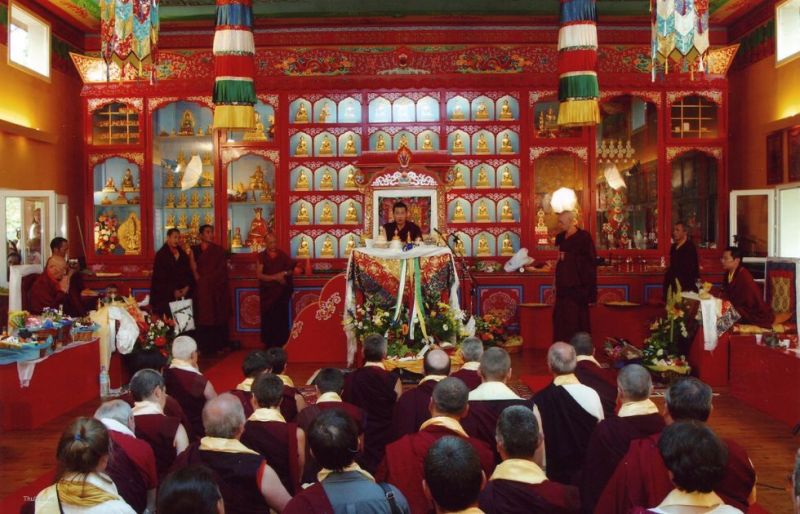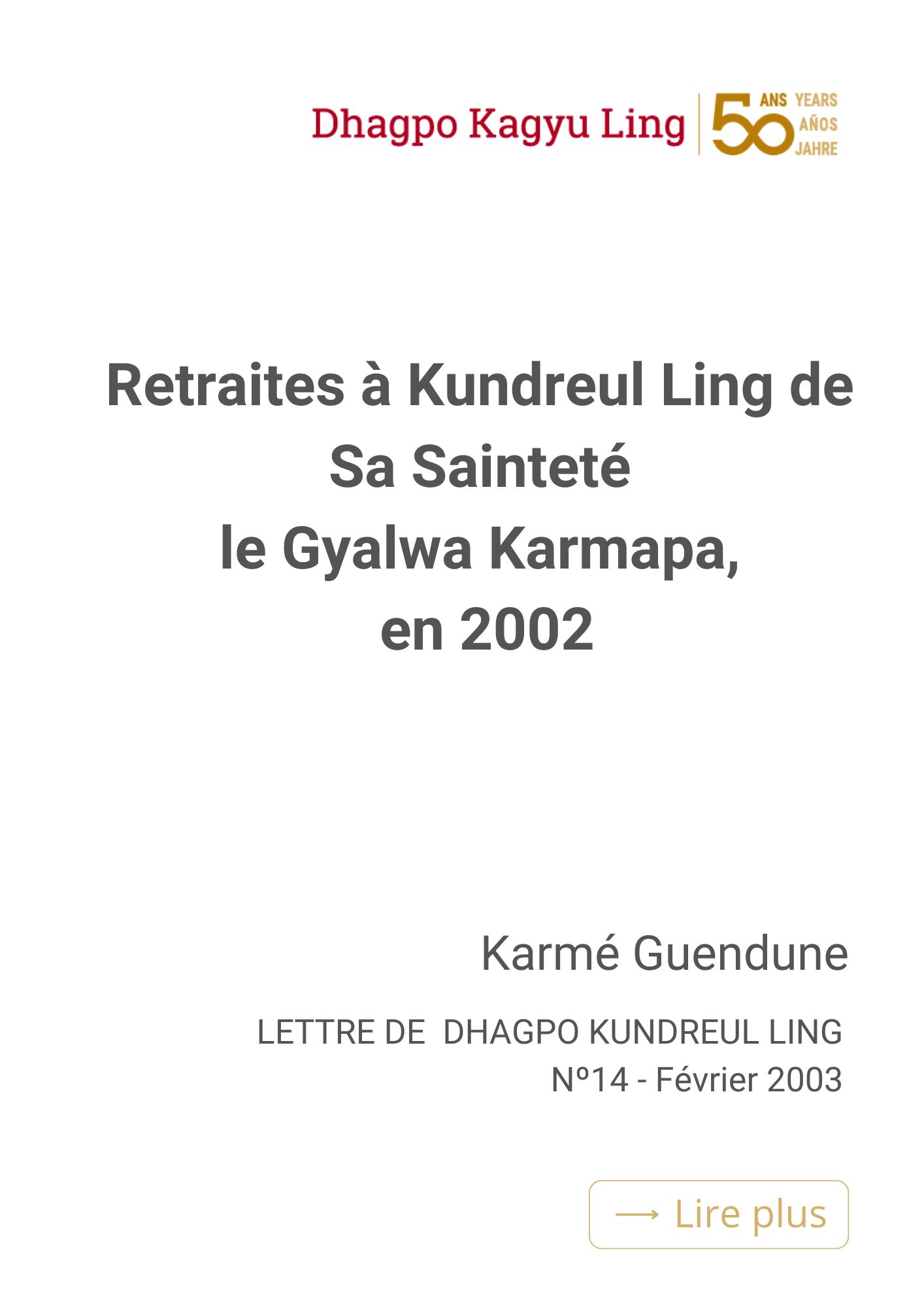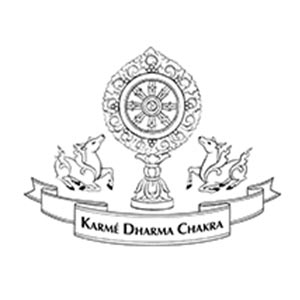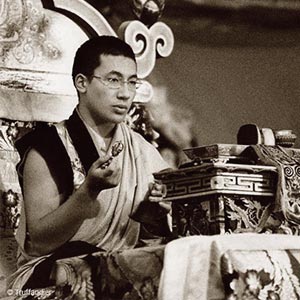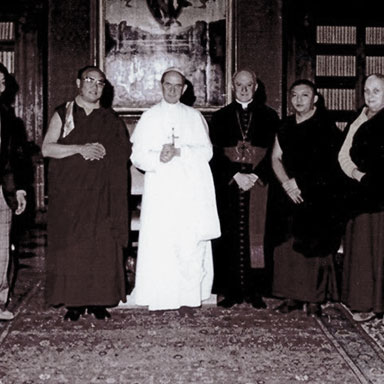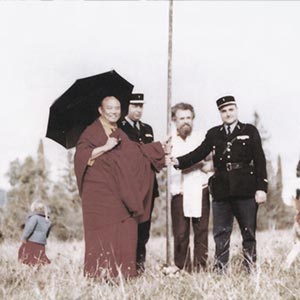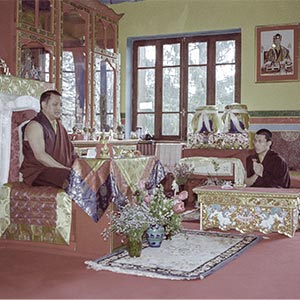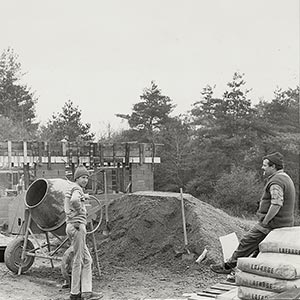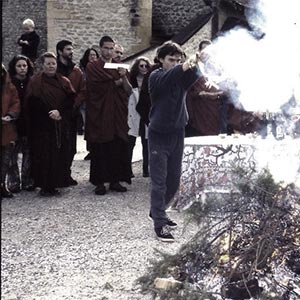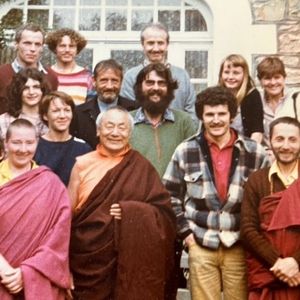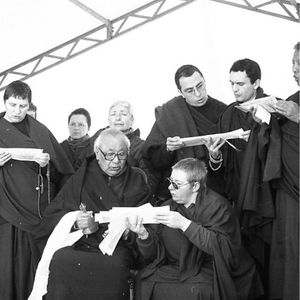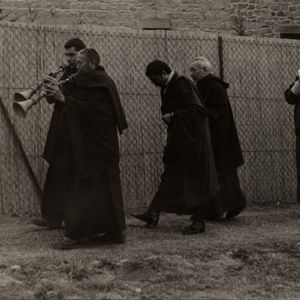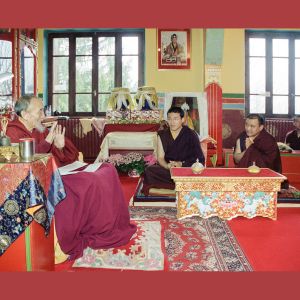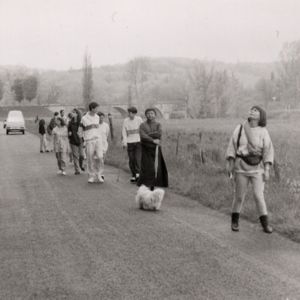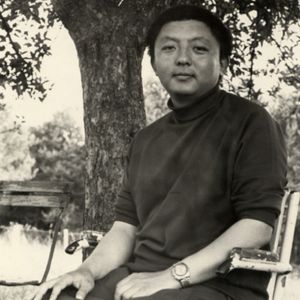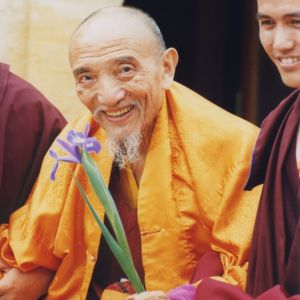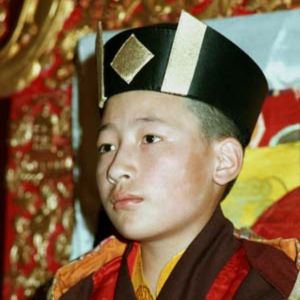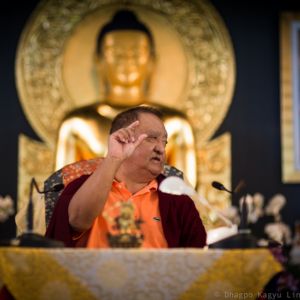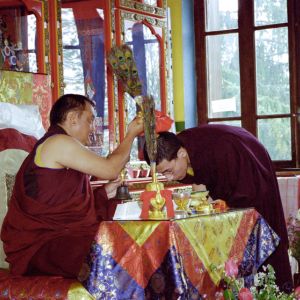Upon the request of Künzig Shamarpa, Khenchen Trinley Paljor Rinpoche, one of the primary holders of the Kagyu lineage transmitted the Karma Kamtsang tradition of the six yogas of Naropa, Dorje Pamo practice and other texts on meditation practice to Thaye Dorje, His Holiness the 17th Karmapa from May 21 to 27, 2002 at Dhagpo Kundreul Ling.
These transmissions (see below) take place prior to Karmapa’s entry into retreat in June, at the monastic hermitage of Le Bost. The two-and-a-half-month retreat was led by Khenchen Rinpoche, with Gyatrul Rinpoche, Nendo Tenam Rinpoche and Drupsing Rinpoche also taking part.
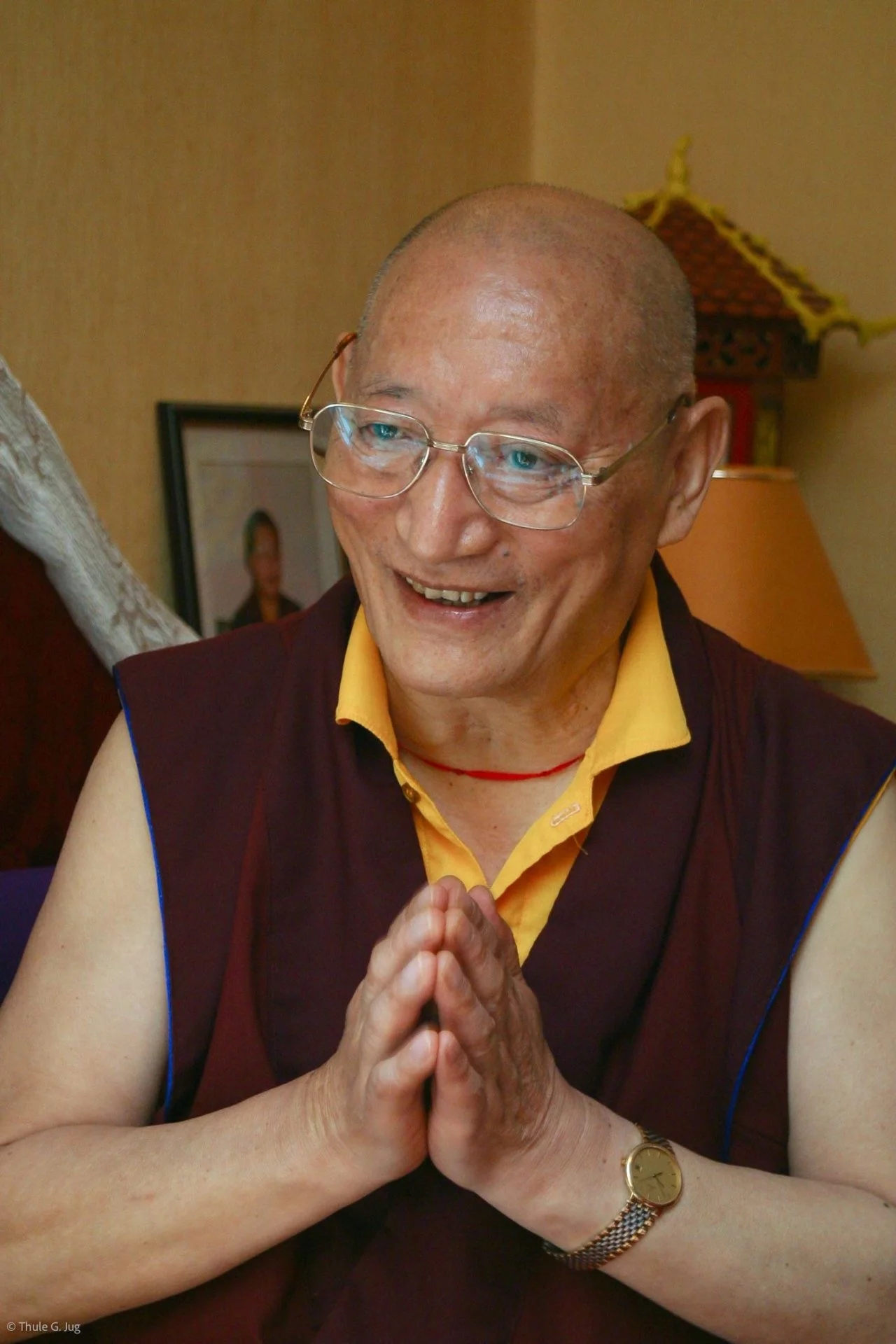 Born in 1930 in Nangshen in the Kham region of eastern Tibet, Khenchen Trinley Paljor Rinpoche entered the Bakyod Samdrup Choling monastery at the age of five. At nineteen, he took the vows of gelong, or fully ordained monk, and began the first of three three-year retreats. During the first two, he received the complete empowerments, ritual reading transmissions (lung) and practice instructions of the Karma Kamtsang lineage. These retreats were conducted in the tradition of the Tsurphu monastery, the historic seat of the Karmapas. It was also at this time that Rinpoche made a pilgrimage to the holy places of central Tibet and met the 16th Gyalwa Karmapa, Rangjung Rigpe Dorje, for the first time. During his third three-year retreat, Rinpoche guided the retreatants as drupön or retreat master.
Born in 1930 in Nangshen in the Kham region of eastern Tibet, Khenchen Trinley Paljor Rinpoche entered the Bakyod Samdrup Choling monastery at the age of five. At nineteen, he took the vows of gelong, or fully ordained monk, and began the first of three three-year retreats. During the first two, he received the complete empowerments, ritual reading transmissions (lung) and practice instructions of the Karma Kamtsang lineage. These retreats were conducted in the tradition of the Tsurphu monastery, the historic seat of the Karmapas. It was also at this time that Rinpoche made a pilgrimage to the holy places of central Tibet and met the 16th Gyalwa Karmapa, Rangjung Rigpe Dorje, for the first time. During his third three-year retreat, Rinpoche guided the retreatants as drupön or retreat master.This third retreat, however, ended prematurely when he was forced to flee Tibet in 1959, to undertake a long and perilous journey to Nepal with four other lamas. These difficulties, which he saw as the result of karma, only strengthened his faith in the Dharma. Once there, he made pilgrimages to the eight sacred sites of the Buddha in Nepal and India. He fulfilled his wish to join the 16th Gyalwa Karmapa in Rumtek, Sikkim, in the mid-sixties. The Karmapa asked him to stay on, and several years later sent him to Bhutan to look after the Tashi Choeling monastery, donated by the 3rd King of Bhutan, His Majesty Jigme Dorji Wangchuck. During this period, Rinpoche received a wealth of essential teachings, transmissions and advice from the 16th Karmapa, as well as from Dilgo Khyentse Rinpoche, an eminent Nyingma master.
When Khenchen Rinpoche wished to enter into lifetime retreat, the 16th Karmapa appointed him personal tutor to Trungram Gyaltrul Rinpoche. During the 90s, he gave numerous teachings in Hong Kong, Taiwan and the United States, notably at the Dharmakaya Center in New York State, where he also led retreats.
In recognition of his spiritual achievement, the 14th Kunzik Shamarpa, Mipham Chökyi Lodrö, conferred on him the title of Rinpoche. In 1999, he received the full title of Khenchen Rinpoche, or superior abbot of monastic ordination, from the 17th Gyalwa Karmapa.
On the occasion of this great master’s parinirvana in January 2022, the 17th Karmapa shared this message with his disciples:
« All of you who have had the good fortune to meet this great practitioner during his lifetime have abundant reasons to rejoice that you were able to witness his teachings on how to live. Degenerate age or not, Khenchen Trinley Paljor practiced the Buddha Dharma and mirrored to all of you how you can practice, regardless of the challenging situations and circumstances that seem to give you no space. I personally rejoice in having had the good fortune of meeting him and receiving precious Dharma transmissions from him, and I will always treasure every single one of these precious moments I spent with him. »
These photos come from our archives or were collected as part of the research for Dhagpo Kagyu Ling’s 50th anniversary. We have not been able to identify all the authors. The use of these photos is solely for informational purposes within the context of Dhagpo Kagyu Ling’s 50th anniversary celebration. Their use is limited to this event and our website and is not for commercial purposes.
Event
This transmission from the master Khenchen Trinley Paljor Rinpoche will be commemorated on May 21 by the extensive practice of Dorje Pamo in the Institute and the screening of the film “From Youth to Mastery”.
This event takes place only onsite.
These photos come from our archives or were collected as part of the research for Dhagpo Kagyu Ling’s 50th anniversary. We have not been able to identify all the authors. The use of these photos is solely for informational purposes within the context of Dhagpo Kagyu Ling’s 50th anniversary celebration. Their use is limited to this event and our website and is not for commercial purposes.
The Six Dharmas of Naropa (Naro chödruk)
The practice of the Six Dharmas of Naropa (sometimes called the Six Yogas) is one of the most advanced Vajrayana practices. It corresponds to the second phase of Unsurpassable Yoga tantras’ practice; the perfection phase, dzogrim, which has two forms—dzogrim with characteristics and dzogrim without characteristics. In the first, the perfection phase with characteristics, the yogi trains while they are engaging in one of the six dharmas. The perfection phase without characteristics corresponds to Mahamudra practice.
In their current form, the Six Dharmas are Tummo (Caṇḍālī, sometimes called Inner Heat, a term which is more a description of its effect than a translation), Illusory Body (Gyulü), Luminosity (Ösel), Dream (Milam), Intermediate State (Bardo), and Transfer (Powa).
These practices, quite sparse in terms of rituals, are based on the oral instructions transmitted from master to disciple and associated with the subtle body. They are linked with the second and third phases (wisdom and word) of major empowerments (wang).
These Six Dharmas were not “invented” by Naropa. They were taught in the tantras including the Guhyasamāja and Hevajra tantras, then received, practiced and systematized by the Indian Buddhist masters of the late first millenia. Tilopa received these various transmissions from four primary lineages, the Four Currents (kabab zhi) and taught them to his disciple Nāropa (d. 1040 CE). During the many years he spent in India, Marpa (1000–1081 CE) received and practiced the Unsurpassable Tantras in his own turn and brought them back to Tibet. Marpa’s teachings are particularly well-known for their key instructions (damngak or menngak)—a term that designates oral instructions particularly focused on the perfection phase—which he received from Naropa and his other masters and which allowed him to practice the Six Dharmas in a particularly efficient way and obtain their fruit. His disciples, Milarepa (1028–1111 CE) first and foremost among them, accomplished Tummo or even Illusory Body in their own right, and these instructions make up the vibrant heart of the Kagyü lineage.
The practice of the Six Dharmas is a very advanced yoga that is only carried out in retreat. In the Karma Kagyü lineage for example, Tummo practice is very often associated with that of Vajravārāhī (Dorje Pamo). The 17th Karmapa received this yidam from Shamar Rinpoche in this way in 2000 at Kundreul Ling. He then carried out a retreat and later received complementary teachings on Vajravārāhī and the transmission of the Six Dharmas of Gampopa from Khenchen Trinle Paljor Rinpoche in 2002, also at Kundreul Ling. Indeed, Gendun Rinpoche trained generations of practitioners in this very same location starting in the early 1980s. They also received and practiced the instruction of various yidams of the Unsurpassable Yoga tantras and Six Dharmas during the traditional three-year retreats, thus continuing a thousand-year-old lineage that stretches back to the Indian and Tibetan masters who actualized the state of Vajradhara in one body and within one lifetime.

